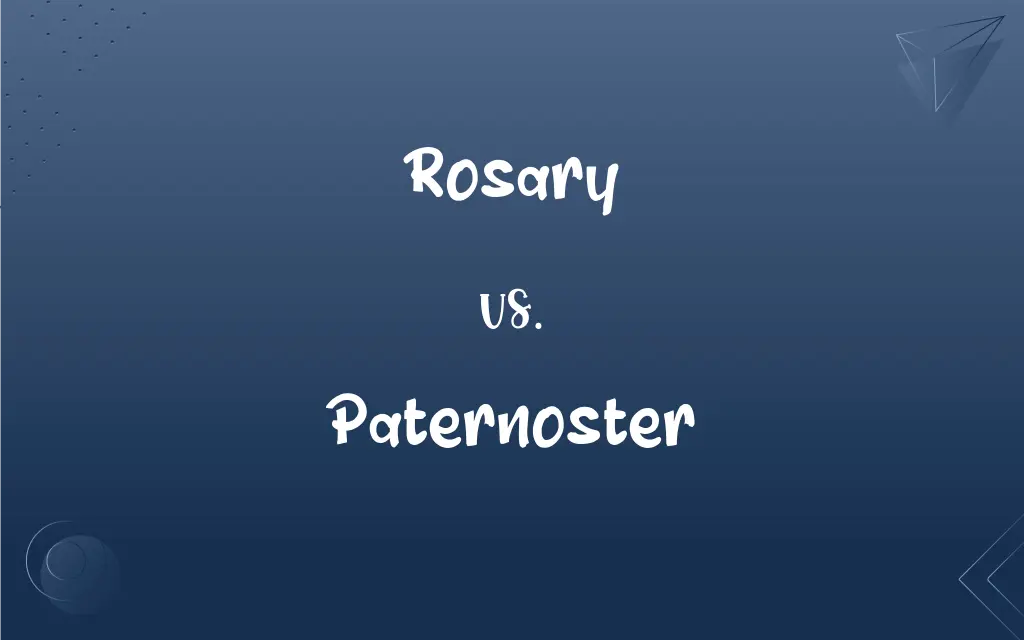Rosary vs. Paternoster: What's the Difference?
By Harlon Moss & Aimie Carlson || Updated on May 22, 2024
A rosary is a string of beads used by Catholics for prayer and meditation, focusing on the life of Christ and the Virgin Mary, a paternoster is specifically the prayer "Our Father" and can also refer to a string of beads used for counting these prayers.

Key Differences
The rosary is a devotional tool in the Catholic Church, consisting of a string of beads used to count prayers and meditate on the life of Jesus Christ and the Virgin Mary. It typically includes sets of ten Hail Marys, each preceded by an Our Father. The paternoster, which literally means "Our Father" in Latin, refers to the prayer itself and historically to a set of prayer beads used in earlier Christian traditions to count repetitions of this prayer.
The rosary's structure includes five sets of ten beads, each set called a decade, used for Hail Marys, with larger beads in between for the Our Father. This structure facilitates meditation on the Mysteries of the Rosary, which are events from the lives of Jesus and Mary. The paternoster, on the other hand, often comprised fewer beads, generally corresponding to the ten Our Father prayers, and lacked the comprehensive structure seen in the rosary. The rosary's development expanded the use of prayer beads to include a broader range of prayers and meditations.
In practice, the rosary is a well-known and widespread devotional practice within the Catholic Church, with a significant emphasis on Marian devotion. The paternoster, while still recognized, is less commonly used today, often considered a precursor to the more elaborate rosary.
While the rosary is used for both personal and communal prayer, the paternoster was more personal and simpler in structure, reflecting an earlier period in Christian devotional practices. The rosary’s evolution showcases the development of Catholic spirituality and its intricate relationship with the Virgin Mary.
Comparison Chart
Primary Focus
Multiple prayers and meditations
"Our Father" prayer
ADVERTISEMENT
Structure
Five decades of ten beads each
Fewer beads, usually ten
Usage
Personal and communal prayer
Primarily personal prayer
Historical Development
More recent, evolved over centuries
Earlier Christian tradition
Devotional Emphasis
Life of Christ and Virgin Mary
Directly on the "Our Father" prayer
Rosary and Paternoster Definitions
Rosary
A devotional practice in Catholicism.
The rosary is a central part of her spiritual life.
ADVERTISEMENT
Paternoster
The "Our Father" prayer.
They began their morning with the paternoster.
Rosary
A string of beads used by Catholics for counting prayers.
She prayed the rosary every evening.
Paternoster
Any prayer sequence centered on the "Our Father."
The monks chanted a paternoster repeatedly.
Rosary
A form of prayer involving meditation on the Mysteries.
The congregation recited the rosary together.
Paternoster
An older form of prayer beads in Christianity.
The museum displayed a medieval paternoster.
Rosary
The physical string of beads itself.
He carried his grandmother's rosary in his pocket.
Paternoster
Historical term for prayer beads.
The paternoster was common before the rosary became widespread.
Rosary
A form of devotion to the Virgin Mary, chiefly consisting of three sets of five decades each of the Hail Mary, each decade preceded by the Lord's Prayer and ending with a doxology.
Paternoster
Often Paternoster The Lord's Prayer.
Rosary
One of these sets of decades.
Paternoster
One of the large beads on a rosary on which the Lord's Prayer is said.
Rosary
A string of beads of 5 or 15 decades on which these prayers are counted.
Paternoster
A sequence of words spoken as a prayer or a magic formula.
Rosary
Similar beads used by other religious groups.
Paternoster
A weighted fishing line having several jointed attachments for hooks connected by beadlike swivels.
Rosary
Prayer beads, a string of beads used to keep track of repetitions in prayer, particularly in the Roman Catholic Marian prayer "Hail Mary" (Ave Maria)
Paternoster
An elevator constructed of a series of doorless compartments hung on chains that move slowly and continuously, allowing passengers to step on and off at will.
Rosary
A Roman Catholic devotion involving the repetition of a series of Marian prayers, usually 5, 15, or 20 decades of "Hail Marys", each decade beginning with "Our Father" and ending with "Glory Be to the Father", but sometimes including other Roman Catholic, Anglican, or Lutheran prayers.
Paternoster
(Christianity) The Lord's Prayer, especially in a Roman Catholic context.
Rosary
(by extension) A series or collection of thoughts, literary pieces, etc. intended for similar contemplation.
Paternoster
A slow, continuously moving lift or elevator consisting of a loop of open-fronted cabins running the height of a building.
Rosary
A 13th-century coin minted in Europe as a counterfeit debased form of the sterling silver penny of Edward I, at first accepted as a halfpenny and then outlawed.
Paternoster
(architecture) A bead-like ornament in mouldings.
Rosary
A rose garden.
Paternoster
(fishing) A tackle rig with a heavy sinker at the end of the line, and one or more hooks on traces at right angles spaced above the sinker.
Rosary
A bed of roses, or place where roses grow.
Paternoster
A string of beads used in counting prayers that are said; a rosary.
Rosary
A series of prayers (see Note below) arranged to be recited in order, on beads; also, a string of beads by which the prayers are counted.
His idolized book, and the whole rosary of his prayers.
Paternoster
Every eleventh bead in a rosary, at which, while counting the beads, the Lord's Prayer is to be repeated.
Rosary
A chapelet; a garland; a series or collection, as of beautiful thoughts or of literary selections.
Every day propound to yourself a rosary or chaplet of good works to present to God at night.
Paternoster
A medieval artisan who crafted rosary beads or prayer nuts.
Rosary
A coin bearing the figure of a rose, fraudulently circulated in Ireland in the 13th century for a penny.
Paternoster
(archaic) A patent medicine, so named because salesmen would pray the Lord's Prayer over it before selling it.
Rosary
Beads used in counting prayers (especially Catholic rosary)
Paternoster
To try to catch (fish, etc.) with a paternoster rig.
Rosary
A series of prayers including Hail Marys and Our Fathers.
They completed the rosary in under 30 minutes.
Paternoster
The Lord's prayer, so called from the first two words of the Latin version.
Paternoster
A beadlike ornament in moldings.
Paternoster
A line with a row of hooks and bead-shaped sinkers.
Paternoster
An elevator of an inclined endless traveling chain or belt bearing buckets or shelves which ascend on one side loaded, and empty themselves at the top.
Paternoster
(Roman Catholic Church) the Lord's Prayer in Latin; translates as `our father'
Paternoster
A type of lift having a chain of open compartments that move continually in a loop so that (agile) passengers can step on or off at each floor
Paternoster
A string of beads used for counting Our Fathers.
He used a paternoster to keep track of his prayers.
FAQs
How many beads are typically on a rosary?
A standard rosary has 59 beads: 53 for Hail Marys, six larger ones for Our Fathers, and additional beads for specific prayers.
What prayers are included in the rosary?
The rosary includes the Our Father, Hail Mary, and Glory Be, among others.
What is the primary difference between a rosary and a paternoster?
A rosary includes multiple prayers and meditations, while a paternoster focuses specifically on the "Our Father" prayer.
Are the terms rosary and paternoster interchangeable?
No, the rosary is a more complex devotional tool, whereas a paternoster is simpler and primarily centered on the "Our Father."
What was the historical use of the paternoster?
The paternoster was used to count repetitions of the Our Father prayer, often by medieval Christians.
Why is the rosary significant in Catholicism?
It serves as a means of meditative prayer, focusing on key events in the lives of Jesus Christ and the Virgin Mary.
How does one pray the rosary?
By reciting specific prayers in a structured order while meditating on the Mysteries of the Rosary.
What are the Mysteries of the Rosary?
They are meditative events from the lives of Jesus and Mary, divided into Joyful, Sorrowful, Glorious, and Luminous Mysteries.
Can a paternoster have different numbers of beads?
Yes, but it typically had ten beads for the ten Our Father prayers.
Is the paternoster still used today?
It is less common today but recognized historically as a precursor to the rosary.
Can non-Catholics use a rosary?
Yes, while it is a Catholic devotional tool, anyone interested can use it for prayer and meditation.
How many Our Fathers are in a traditional rosary?
There are six Our Fathers in a traditional rosary.
What is the origin of the term 'rosary'?
It comes from the Latin "rosarium," meaning "rose garden," symbolizing a bouquet of prayers.
What is a decade in the context of the rosary?
A decade refers to a set of ten Hail Marys, preceded by an Our Father and followed by a Glory Be.
What materials are rosary beads made of?
They can be made of wood, metal, glass, plastic, or precious stones.
How is a rosary used in communal prayer?
It is often recited aloud in groups, with participants responding in turn.
Why is the "Our Father" called the paternoster?
"Paternoster" is Latin for "Our Father," the opening words of the prayer.
What is the purpose of using beads in prayer?
Beads help keep track of the number of prayers recited and aid in focusing meditation.
Is the structure of the rosary uniform worldwide?
While the structure is generally consistent, there are some variations in prayers and additional elements in different cultures.
How often do Catholics pray the rosary?
Many pray it daily, while others may pray it weekly or on specific occasions.
About Author
Written by
Harlon MossHarlon is a seasoned quality moderator and accomplished content writer for Difference Wiki. An alumnus of the prestigious University of California, he earned his degree in Computer Science. Leveraging his academic background, Harlon brings a meticulous and informed perspective to his work, ensuring content accuracy and excellence.
Co-written by
Aimie CarlsonAimie Carlson, holding a master's degree in English literature, is a fervent English language enthusiast. She lends her writing talents to Difference Wiki, a prominent website that specializes in comparisons, offering readers insightful analyses that both captivate and inform.
































































